The African Swine Fever Epidemic in Wild Boar (Sus scrofa) in Lithuania (2014–2018)
Abstract
1. Introduction
2. Materials and Methods
3. Results
3.1. Wild Boar Hunting Bag in Lithuania (2013–2019)
3.2. Proportion of ASF Positive Wild Boar in Lithuania (2014–2018)
3.3. ASF Distribution by Sex and Age Class of Wild Boar in Lithuania (2014–2018)
3.4. Seasonal Distribution of ASF in Lithuania during 2014–2018
3.5. Spatial Distribution and Spreading Speed of ASF in Lithuania (2014–2018)
3.6. Measures Undertaken in Lithuania to Control ASF
4. Discussion
5. Conclusions
Supplementary Materials
Author Contributions
Funding
Conflicts of Interest
References
- Boklund, A.; Cay, B.; Depner, K.; Földi, Z.; Guberti, V.; Masiulis, M.; Miteva, A.; More, S.; Olsevskis, E.; European Food Safety Authority (EFSA); et al. Epidemiological analyses of African swine fever in the European Union (November 2017 until November 2018). EFSA J. 2018, 16, 34–52. [Google Scholar]
- Depner, K.; Gortazar, C.; Guberti, V.; Masiulis, M.; More, S.; Oļševskis, E.; Thulke, H.-H.; Viltrop, A.; Woźniakowski, G.; European Food Safety Authority (EFSA). Epidemiological analyses of African swine fever in the Baltic States and Poland. EFSA J. 2017, 15, e05068. [Google Scholar] [CrossRef]
- Chenais, E.; Depner, K.; Guberti, V.; Dietze, K.; Viltrop, A.; Ståhl, K. Epidemiological considerations on African swine fever in Europe 2014—2018. Porc. Health Manag. 2019, 5, 6. [Google Scholar] [CrossRef] [PubMed]
- Schulz, K.; Conraths, F.J.; Blome, S.; Staubach, C.; Sauter-Louis, C. African Swine Fever: Fast and Furious or Slow and Steady? Viruses 2019, 866. [Google Scholar] [CrossRef] [PubMed]
- Depner, K.R.; Blome, S.; Staubach, C.; Probst, C.; Globig, A.; Dietze, K.; Sauter-Louis, C.; Conraths, F.J. Die Afrikanische Schweinepest? Eine Habitatseuche mit häufig niedriger Kontagiosität. Prakt. Tierarzt 2016, 97, 536–544. [Google Scholar]
- Council of the European Union. Commission Decision of 26 May 2003 Approving an African Swine Fever Diagnostic Manual; Notified under document number C(2003) 1696; Council of the European Union: Brussels, Belgium, 2003. [Google Scholar]
- State Food and Veterinary Service of Lithuania (SFVS). On Approval of the Description of the Procedure for Payment for Hunted Wild Boar Females; Vol. Order No B1-1028; SFVS: Vilnius, Lithuania, 2015. [Google Scholar]
- State Food and Veterinary Service of Lithuania (SFVS). On Approving the Description of the Payment Scheme for Wild Boar Carcasses; Vol. Order No B1-108 Nr. B1-611, 2017-09-29; published TAR 2017-09-29; identification code 2017-15390; SFVS: Vilnius, Lithuania, 2016. [Google Scholar]
- Gervasi, V.; Marcon, A.; Bellini, S.; Guberti, V. Evaluation of the Efficiency of Active and Passive Surveillance in the Detection of African Swine Fever in Wild Boar. Vet. Sci. 2019, 5. [Google Scholar] [CrossRef] [PubMed]
- Blome, S.; Gabriel, C.; Beer, M. Pathogenesis of African swine fever in domestic pigs and European wild boar. Virus Res. 2013, 173, 122–130. [Google Scholar] [CrossRef] [PubMed]
- Nurmoja, I.; Motus, K.; Kristian, M.; Niine, T.; Schulz, K.; Depner, K.; Viltrop, A. Epidemiological analysis of the 2015–2017 African swine fever outbreaks in Estonia. Prev. Vet. Med. 2018. [Google Scholar] [CrossRef] [PubMed]
- Schulz, K.; Olsevskis, E.; Staubach, C.; Lamberga, K.; Serzants, M.; Cvetkova, S.; Conraths, F.J.; Sauter-Louis, C. Epidemiological evaluation of Latvian control measures for African swine fever in wild boar on the basis of surveillance data. Sci. Rep. 2019, 9, 4189. [Google Scholar] [CrossRef] [PubMed]
- Enetwild Consortium; Keuling, O.; Sange, M.; Acevedo, P.; Podgorski, T.; Smith, G.; Scandura, M.; Apollonio, M.; Ferroglio, E.; Vicente, J. Guidance on estimation of wild boar population abundance and density: Methods, challenges, possibilities. EFSA Support. Publ. 2018, 15. [Google Scholar] [CrossRef]
- European Commission (EC). Working Document Strategic Approach to the Management of African Swine Fever for the EU; Vol. SANTE/7113/2015—Rev 10; EC: Brussels, Belgium, 2018. [Google Scholar]
- Massei, G.; Kindberg, J.; Licoppe, A.; Gacic, D.; Sprem, N.; Kamler, J.; Baubet, E.; Hohmann, U.; Monaco, A.; Ozolins, J.; et al. Wild boar populations up, numbers of hunters down? A review of trends and implications for Europe. Pest Manag. Sci. 2015, 71, 492–500. [Google Scholar] [CrossRef] [PubMed]
- Schulz, K.; Staubach, C.; Blome, S.; Viltrop, A.; Nurmoja, I.; Conraths, F.J.; Sauter-Louis, C. Analysis of Estonian surveillance in wild boar suggests a decline in the incidence of African swine fever. Sci. Rep. 2019, 9, 8490. [Google Scholar] [CrossRef] [PubMed]
- Probst, C.; Globig, A.; Knoll, B.; Conraths, F.J.; Depner, K. Behaviour of free ranging wild boar towards their dead fellows: Potential implications for the transmission of African swine fever. R Soc. Open Sci. 2017, 4, 170054. [Google Scholar] [CrossRef] [PubMed]
- Blome, S.; Gabriel, C.; Dietze, K.; Breithaupt, A.; Beer, M. High virulence of African swine fever virus caucasus isolate in European wild boars of all ages. Emerg. Infect. Dis. 2012, 18, 708. [Google Scholar] [CrossRef] [PubMed]
- Keuling, O.; Stier, N.; Roth, M. Annual and seasonal space use of different age classes of female wild boar Sus scrofa L. Eur. J. Wildl. Res. 2008, 54, 403–412. [Google Scholar] [CrossRef]
- Merta, D.; Bobek, B.; Albrycht, M.; Furtek, J. The age structure and sex ratio in wild boar (Sus scrofa) populations as determined by observations of free-roaming populations and by harvests of collective hunts in southern Poland. Eur. J. Wildl. Res. 2015, 61, 167–170. [Google Scholar] [CrossRef]
- Náhlik, A.; Sándor, G. Birth rate and offspring survival in a free-ranging wild boar (Sus scrofa) population. Wildl. Biol. 2003, 9, 37–42. [Google Scholar]
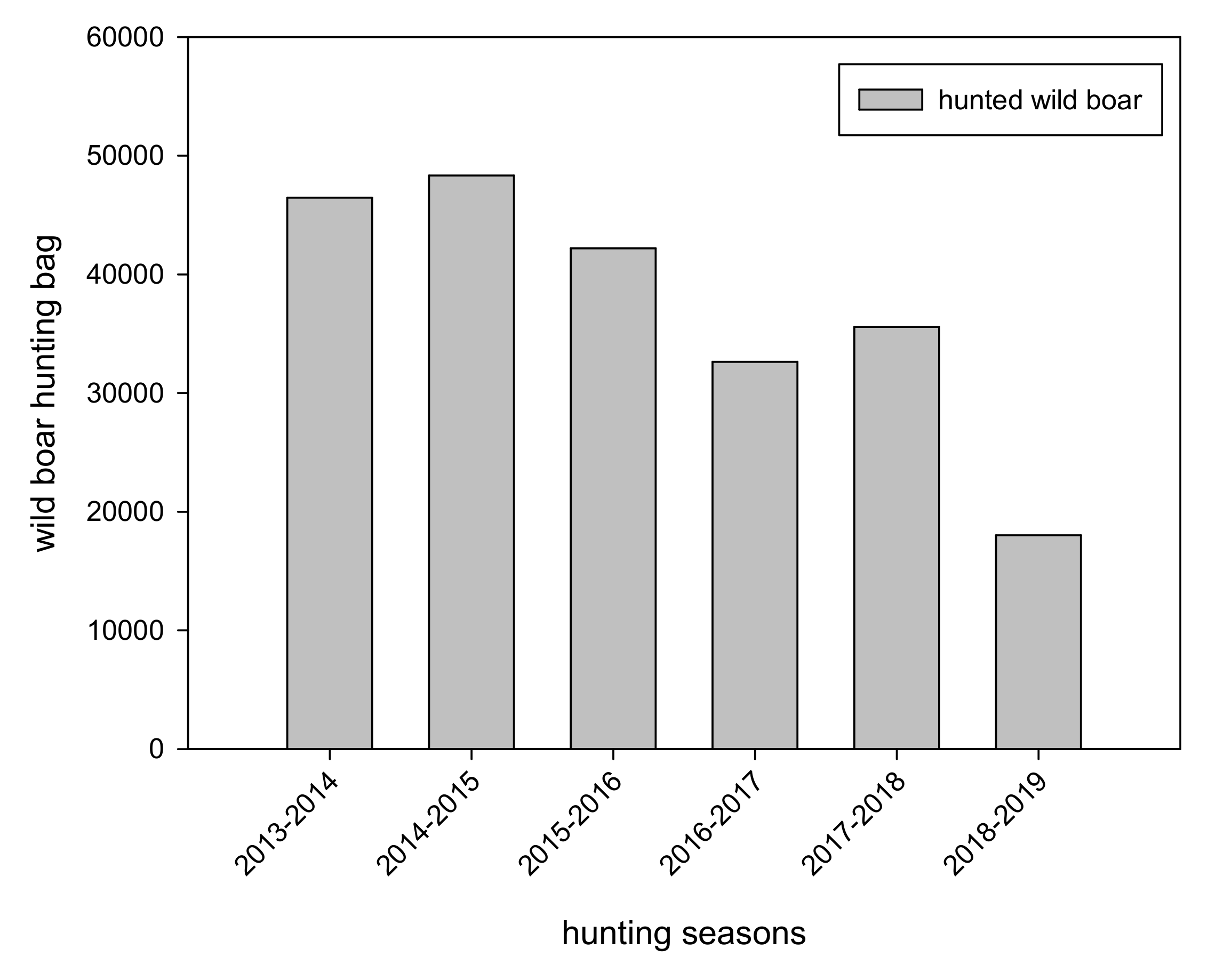
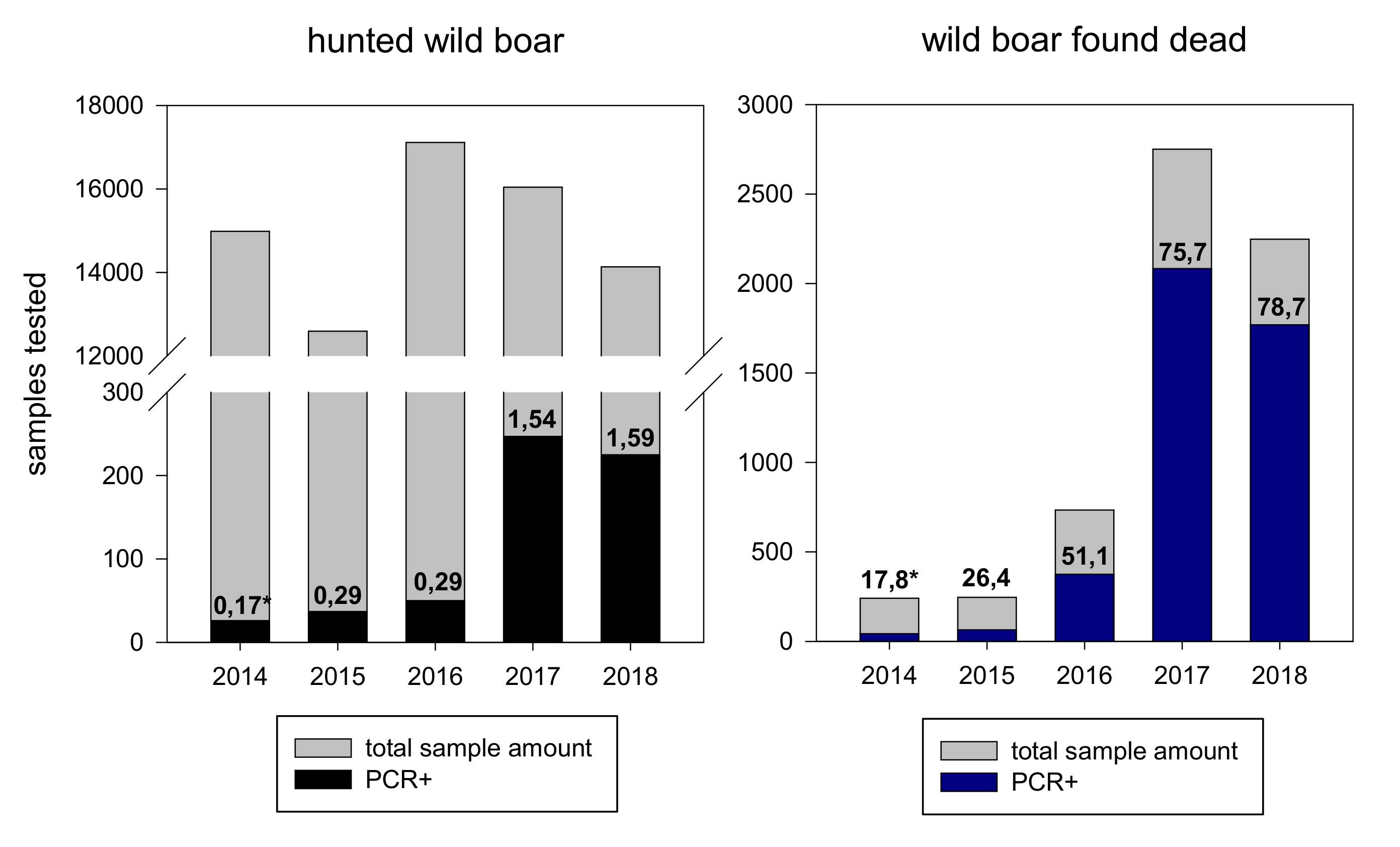
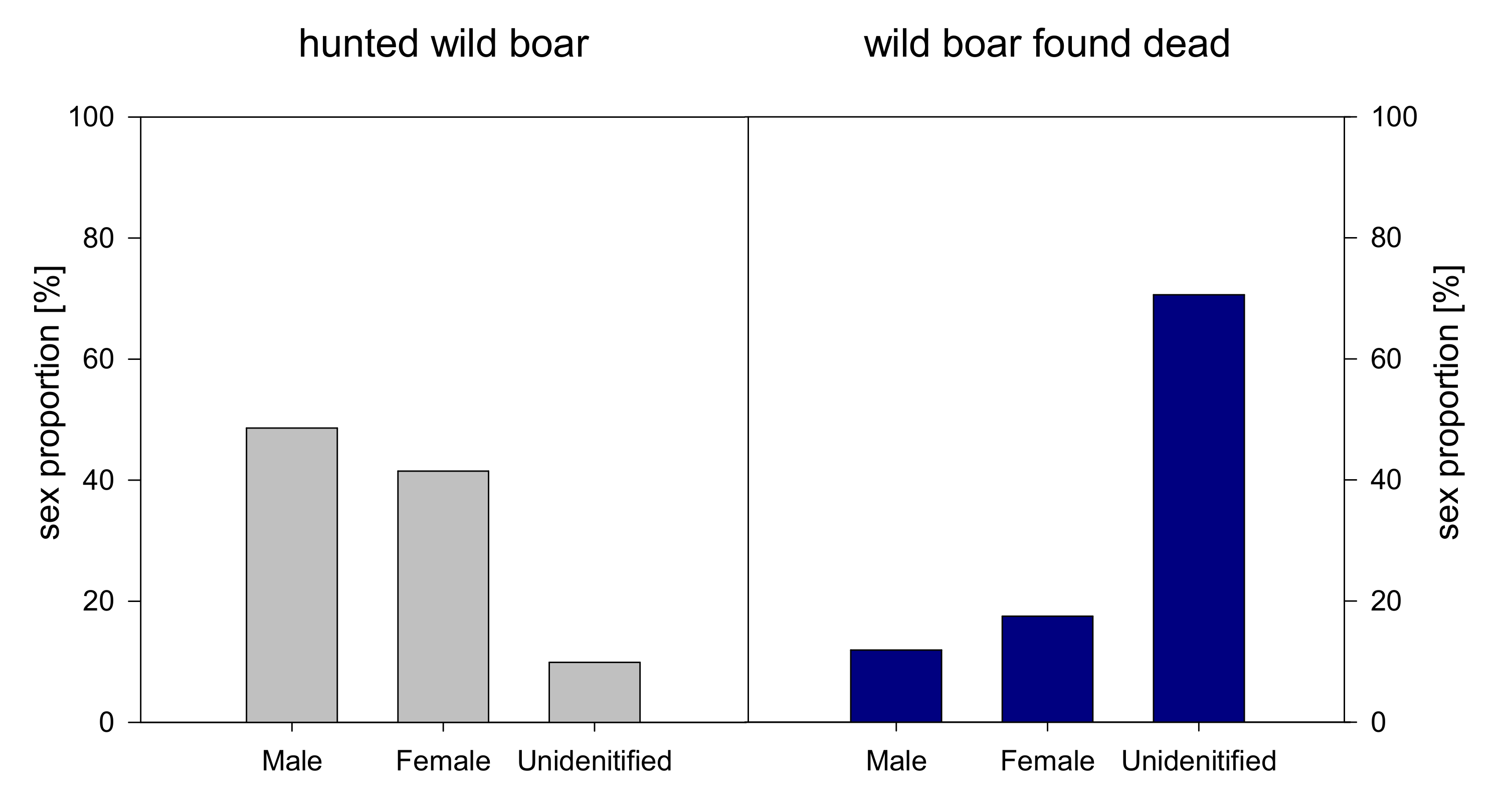
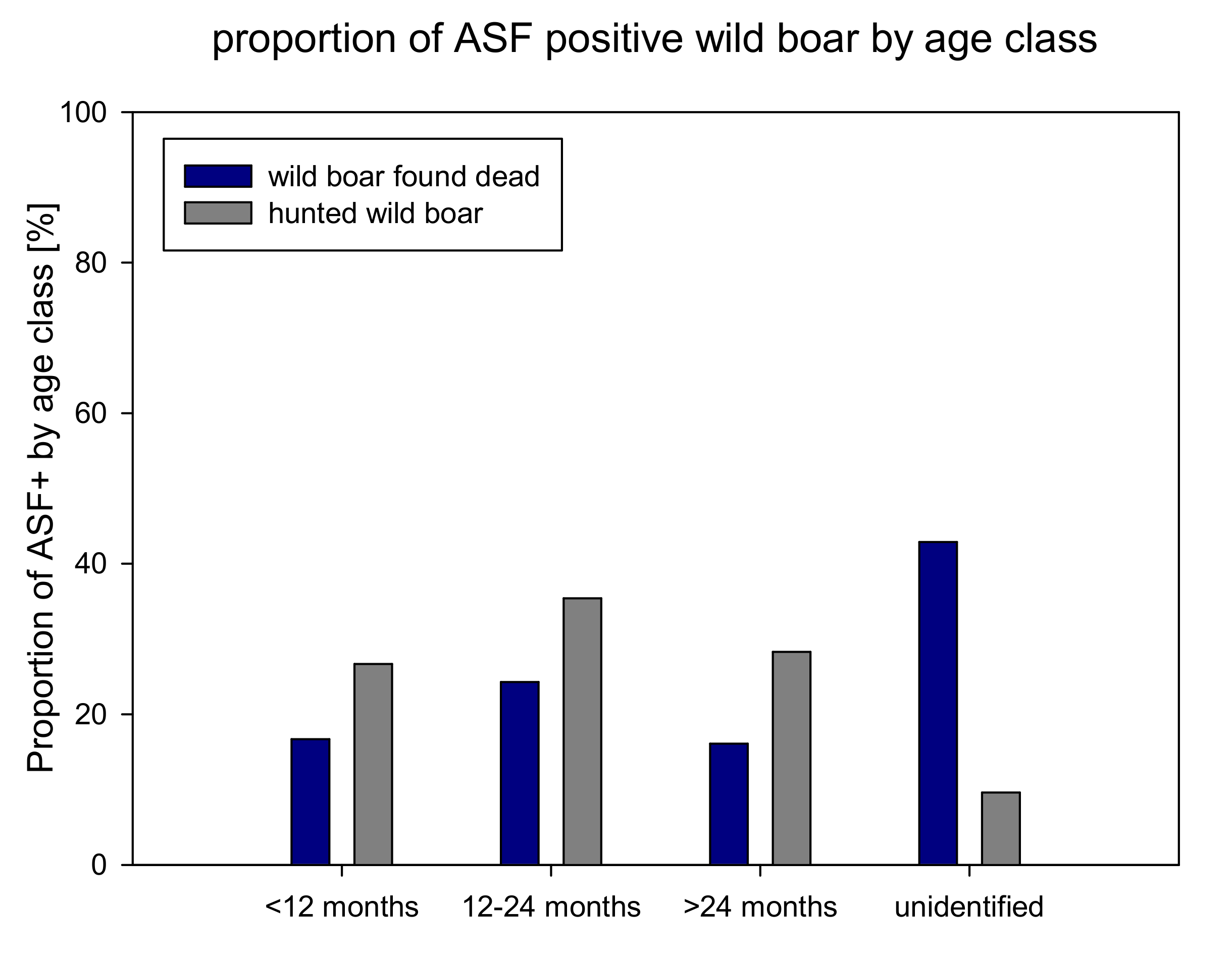

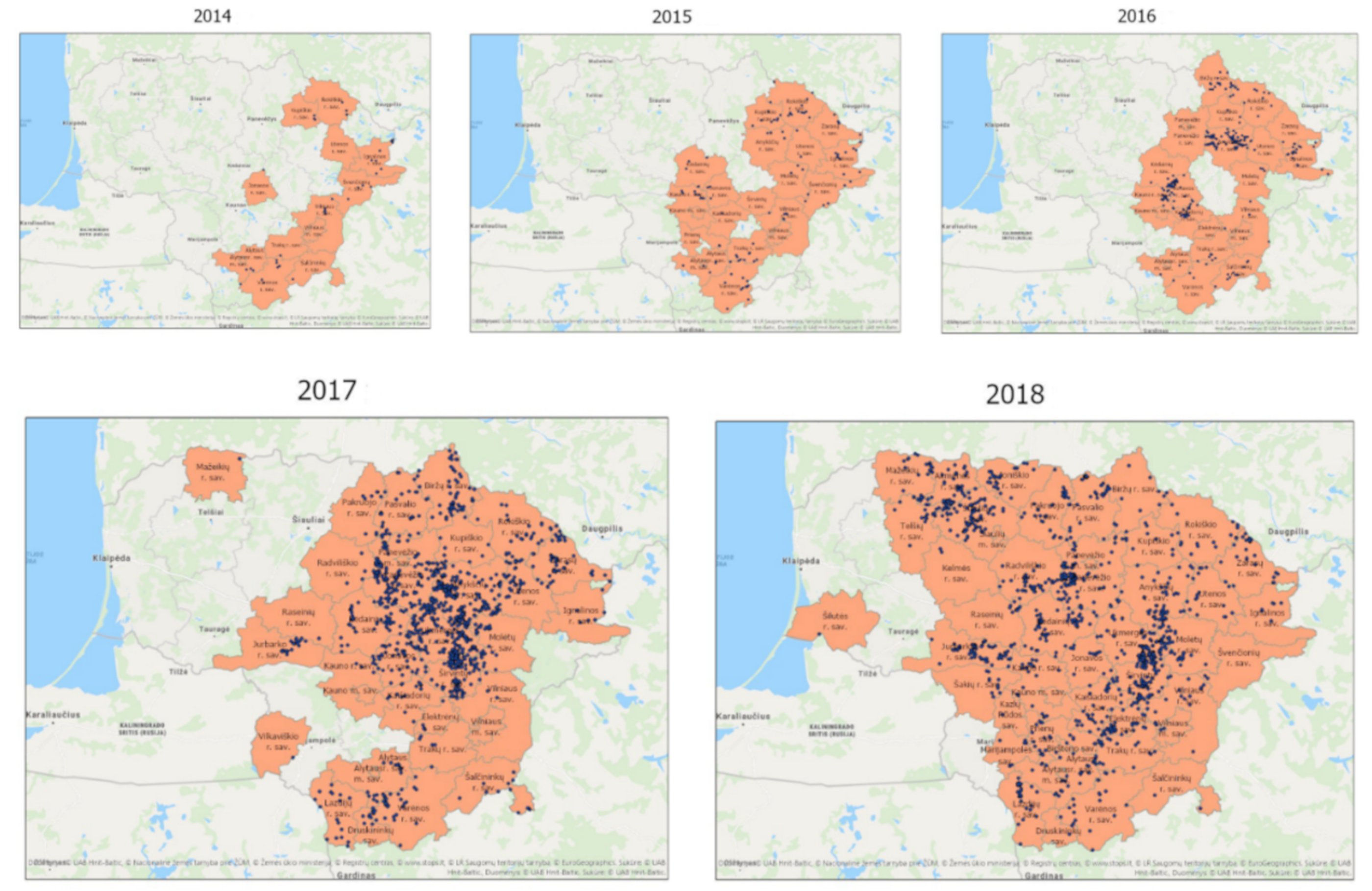

| Year | Outbreaks in Domestic Pigs | Wild Boar Cases | Affected Regional Municipalities | Territory Affected by ASF In Wild Boar * | |
|---|---|---|---|---|---|
| Proportion of Affected Regional Municipalities [%] | Proportion Affected Elderships of Regional Municipalities [%] | ||||
| 2014 | 6 | 45 | 11 | 26 | 7 |
| 2015 | 13 | 110 | 18 | 40 | 14 |
| 2016 | 19 | 303 | 19 | 41 | 17 |
| 2017 | 30 | 1321 | 30 | 60 | 37 |
| 2018 | 51 | 1446 | 41 | 84 | 53 |
| Total | 119 | 3225 | 42 | 86 | 53 |
© 2020 by the authors. Licensee MDPI, Basel, Switzerland. This article is an open access article distributed under the terms and conditions of the Creative Commons Attribution (CC BY) license (http://creativecommons.org/licenses/by/4.0/).
Share and Cite
Mačiulskis, P.; Masiulis, M.; Pridotkas, G.; Buitkuvienė, J.; Jurgelevičius, V.; Jacevičienė, I.; Zagrabskaitė, R.; Zani, L.; Pilevičienė, S. The African Swine Fever Epidemic in Wild Boar (Sus scrofa) in Lithuania (2014–2018). Vet. Sci. 2020, 7, 15. https://doi.org/10.3390/vetsci7010015
Mačiulskis P, Masiulis M, Pridotkas G, Buitkuvienė J, Jurgelevičius V, Jacevičienė I, Zagrabskaitė R, Zani L, Pilevičienė S. The African Swine Fever Epidemic in Wild Boar (Sus scrofa) in Lithuania (2014–2018). Veterinary Sciences. 2020; 7(1):15. https://doi.org/10.3390/vetsci7010015
Chicago/Turabian StyleMačiulskis, Petras, Marius Masiulis, Gediminas Pridotkas, Jūratė Buitkuvienė, Vaclovas Jurgelevičius, Ingrida Jacevičienė, Rūta Zagrabskaitė, Laura Zani, and Simona Pilevičienė. 2020. "The African Swine Fever Epidemic in Wild Boar (Sus scrofa) in Lithuania (2014–2018)" Veterinary Sciences 7, no. 1: 15. https://doi.org/10.3390/vetsci7010015
APA StyleMačiulskis, P., Masiulis, M., Pridotkas, G., Buitkuvienė, J., Jurgelevičius, V., Jacevičienė, I., Zagrabskaitė, R., Zani, L., & Pilevičienė, S. (2020). The African Swine Fever Epidemic in Wild Boar (Sus scrofa) in Lithuania (2014–2018). Veterinary Sciences, 7(1), 15. https://doi.org/10.3390/vetsci7010015





